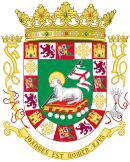Status quo movement in Puerto Rico
 |
|---|
|
The status quo movement in Puerto Rico refers to initiatives throughout the history of Puerto Rico aimed at maintaining the current political status of Puerto Rico, that of a commonwealth of the United States.
Puerto Rico is currently a territory of the United States. As a Commonwealth, Puerto Rico receives less in federal funding than the states. Residents are US citizens and can vote in territorial and local elections, but do not have the right to vote in presidential or Congressional elections. They receive lower Social Security and Medicare benefits. The Commonwealth and municipal governments of Puerto Rico are prohibited from filing for bankruptcy.[1]
In the 2012 Puerto Rican status referendum, 54% of the ballots cast were against the continuation of the island's status as a territory of the US. Of the votes for new status, a 61.1% majority chose statehood.[2][3][4] This was by far the most successful referendum for statehood advocates. In all earlier referenda, votes for statehood were matched almost equally by votes for remaining an American territory, with the remainder for independence. Support for U.S. statehood has risen in each successive popular referendum.[5][6]
On December 11, 2012, the Legislative Assembly of Puerto Rico enacted a concurrent resolution to request the President and the Congress of the United States, to respond diligently and effectively, and to act on the demand of the people of Puerto Rico, as freely and democratically expressed in the plebiscite held on November 6, 2012, to end, once and for all, its current form of territorial status and to begin the process of admission of Puerto Rico as a State.[7] The government did not take steps to meet this request, but provided funding for a fifth referendum.[8][9]
The 2017 Puerto Rican status referendum held on June 11 of that year, offered three options: "Statehood", "Current Territorial Status" and "Independence/Free Association." The result was over 97% of votes cast favored statehood. However, the legitimacy of the referendum was called into question due to all major parties that oppose statehood boycotting the referendum due to the phrasing of the ballot. Voter turnout was only 23%.[10] Regardless of the outcome of this fifth referendum, action by the United States Congress is necessary (and has not yet been taken) to implement changes to the status of Puerto Rico under the Territorial Clause of the United States Constitution.
See also[]
- 51st state
- Political status of Puerto Rico
- Puerto Rico (proposed state)
- Special Committee on Decolonization
- Proposed political status for Puerto Rico
References[]
- ^ Coto, Danica (February 3, 2017). "Puerto Rico gov approves referendum in quest for statehood". Washington Post. DC. Archived from the original on February 4, 2017. Retrieved February 17, 2017.
- ^ "Puerto Rico votes for U.S. statehood in non-binding referendum". CBS News. Retrieved November 8, 2012.
- ^ "CEE Event". Archived from the original on November 7, 2012. Retrieved November 8, 2012.
- ^ "Puerto Rico vote could change ties to U.S." SFGate. Associated Press. November 4, 2012. Retrieved November 8, 2012.
- ^ "An Introduction to Puerto Rico's Status Debate". Let Puerto Rico Decide. Archived from the original on February 16, 2012. Retrieved March 29, 2012.
- ^ Puerto Ricans favor statehood for first time, CNN, 7 November 2012
- ^ "The Senate and the House of Representative of Puerto Rico Concurrent Resolution" (PDF). puertoricoreport.org.
- ^ "U.S. approves funds for referendum on Puerto Rico's status". January 16, 2014. Archived from the original on January 20, 2014. Retrieved January 19, 2014.
- ^ "Make room for 51st star? Spending bill includes $2.5 million for vote on Puerto RIco statehood". January 22, 2014. Retrieved January 22, 2014.
- ^ Robles, Frances (June 11, 2017). "23% of Puerto Ricans Vote in Referendum, 97% of Them for Statehood". The New York Times. Retrieved April 7, 2018.
- Political advocacy groups in Puerto Rico
- Puerto Rico stubs